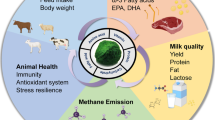Abstract
The effects of three emulsifying methods on ruminal fatty acid biohydrogenation (BH) in vitro were compared. Using a static in-vitro gas test system, four replicates of each treatment were incubated in buffered ruminal fluid. Hemicellulose (300 mg dry matter) was supplemented either with or without linoleic acid (9c12c-18:2, 5% in diet dry matter) and incubated for 4 and 24 h. Three methods of emulsifying 9c12c-18:2 were tested: (1) ethanol, (2) Tween® 80, and (3) sonication. The products were then compared to non-emulsified 9c12c-18:2. Out of the three emulsifying methods tested, ethanol and sonication resulted in stable 9c12c-18:2 emulsions, indicating good 9c12c-18:2 distribution, while the Tween® 80 emulsion was less stable. BH was strongly inhibited by treating 9c12c-18:2 with ethanol and sonication at different steps of the BH-pathway, resulting in changed concentrations of certain BH intermediates. The fatty acid profile generated from the major BH-pathways of 9c12c-18:2 with Tween® 80 was comparable to that without emulsification after 24 h of incubation. We conclude that it is not recommended to emulsify lipids before incubating them in vitro when investigating fatty acid BH. If emulsification of 9c12c-18:2 is necessary, Tween® 80 seems to be the method that interferes least with BH.
Similar content being viewed by others
Abbreviations
- BH:
-
Biohydrogenation
- FAME:
-
Fatty acid methyl esters
- LNA:
-
Linoleic acid
- PUFA:
-
Polyunsaturated fatty acids
References
AbuGhazaleh AA, Riley MB, Thies EE, Jenkins TC (2005) Dilution rate and pH effects on the conversion of oleic acid to trans C18:1 positional isomers in continuous culture. J Dairy Sci 88:4334–4341
Harfoot CG, Noble RC, Moore JH (1973) Factors influencing the extent of biohydrogenation of linoleic acid by rumen micro-organisms in vitro. J Sci Food Agric 24:961–970
Wallace RJ, McKain N, Shingfield KJ, Devillard E (2007) Isomers of conjugated linoleic acids are synthesized via different mechanisms in ruminal digesta and bacteria. J Lipid Res 48:2247–2254
Fievez V, Vlaeminck B, Jenkins T, Enjalbert F, Doreau M (2007) Assessing rumen biohydrogenation and its manipulation in vivo, in vitro and in situ. Eur J Lipid Sci Technol 109:740–756
Beam TM, Jenkins TC, Moate PJ, Kohn RA, Palmquist DL (2000) Effect of amount and source of fat on the rates of lipolysis and biohydrogenation of fatty acids in ruminal contents. J Dairy Sci 83:2564–2573
Moate PJ, Boston RC, Jenkins TC, Lean IJ (2008) Kinetics of ruminal lipolysis of triacyglycerol and biohydrogenation of long-chain fatty acids: new insights from old data. J Dairy Sci 91:731–742
Dohme F, Machmüller A, Wasserfallen A, Kreuzer M (2001) Ruminal methanogenesis as influenced by individual fatty acids supplemented to complete ruminant diets. Lett Appl Microbiol 32:47–51
Maia MRG, Chaudhary LC, Figueres L, Wallace RJ (2007) Metabolism of polyunsaturated fatty acids and their toxicity to the microflora of the rumen. Antonie Van Leeuwenhoek 91:303–314
Yoshii T, Asanuma N, Hino T (2005) Effect of ethanol on nitrate and nitrite reduction and methanogenesis in the ruminal microbiota. Anim Sci J 76:37–42
Soliva CR, Hess HD (2007) Measuring methane emission of ruminants by in vitro and in vivo techniques. In: Makkar HPS, Vercoe PE (eds) Measuring methane production from ruminants. Springer, Dordrecht
Fellner V, Sauer FD, Kramer JKG (1995) Steady-state rates of linoleic acid biohydrogenation by ruminal bacteria in continuous culture. J Dairy Sci 78:1815–1823
Smedes F (1999) Determination of total lipid using non-chlorinated solvents. Analyst 124:1711–1718
Aldai N, Murray BE, Nájera AI, Troy DJ, Osoro K (2005) Derivatization of fatty acids and its application for conjugated linoleic acid studies in ruminant meat lipids. J Sci Food Agric 85:1073–1083
Kramer JKG, Zhou J (2001) Conjugated linoleic acid and octadecanoic acids: extraction and isolation of lipids. Eur J Lipid Sci Technol 103:594–600
Kramer JKG, Blackadar CB, Zhou J (2002) Evaluation of two GC columns (60-m SUPELCOWAX 10 and 100-m CP Sil 88) for analysis of milkfat with emphasis on CLA, 18:1, 18:2 and 18:3 isomers, and short- and long-chain FA. Lipids 37:823–835
Khiaosa-Ard R, Bryner SF, Scheeder MRL, Wettstein H-R, Leiber F, Kreuzer M, Soliva CR (2009) Evidence for the inhibition of the terminal step of ruminal α-linolenic acid biohydrogenation by condensed tannins. J Dairy Sci 92:177–188
Li Y, Meng Q (2006) Effect of different types of fibre supplemented with sunflower oil on ruminal fermentation and production of conjugated linoleic acids in vitro. Arch Anim Nutr 60:402–411
Czerkawski JW (1967) Incubation inside the bovine rumen. Br J Nutr 21:865–878
Wu Z, Ohajuruka OA, Palmquist DL (1991) Ruminal synthesis, biohydrogenation, and digestibility of fatty acids by dairy cows. J Dairy Sci 74:3025–3034
Scollan ND, Dhanoa MS, Choi NJ, Maeng WJ, Enser M, Wood JD (2001) Biohydrogenation and digestion of long chain fatty acids in steers fed on different sources of lipid. J Agric Sci 136:345–355
Harfoot CG, Hazlewood GP (1997) Lipid metabolism in the rumen. In: Hobson PN, Stewart CS (eds) The rumen microbial ecosystem. 2nd edn. Blackie Academic & Professional, London
Harfoot CG, Noble RC, Morre JH (1973) Food particles as a site for biohydrogenation of unsaturated fatty acids in the rumen. Biochem J 132:829–832
Harfoot CG, Noble RC, Moore JH (1975) The role of plant particles, bacteria and cell-free supernatant fractions of rumen contents in the hydrolysis of trilinolein and the subsequent hydrogenation of linoleic acid. Antonie Van Leeuwenhoek 41:533–542
Caldwell DR, Murray K (1986) Some effects of ethyl alcohol on the growth of rumen bacteria. Curr Microbiol 14:193–197
Acknowledgments
We owe our thanks to Prof. M. Kreuzer for his support in the planning of this experiment.
Author information
Authors and Affiliations
Corresponding author
About this article
Cite this article
Khiaosa-ard, R., Leiber, F. & Soliva, C.R. Methods of Emulsifying Linoleic Acid in Biohydrogenation Studies In Vitro May Bias the Resulting Fatty Acid Profiles. Lipids 45, 651–657 (2010). https://doi.org/10.1007/s11745-010-3440-1
Received:
Accepted:
Published:
Issue Date:
DOI: https://doi.org/10.1007/s11745-010-3440-1




